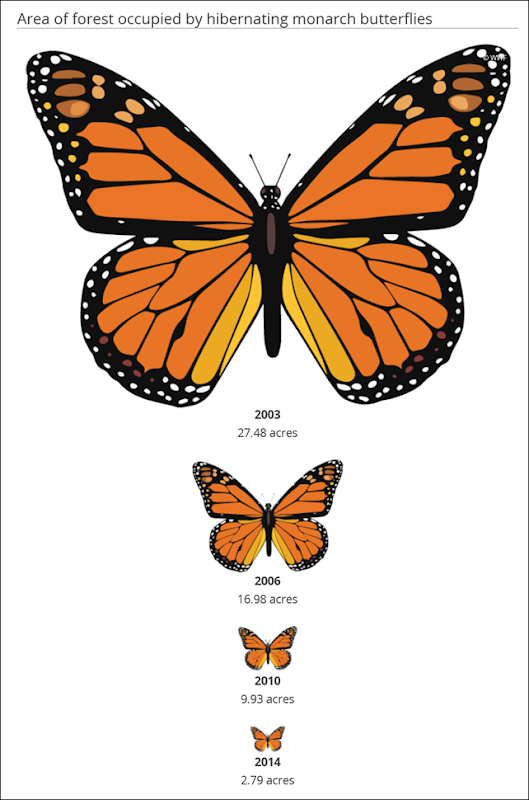Monarch butterfly population still perilously low, new survey finds
By Jeremy Hance
28 January 2015 (mongabay.com) – The world’s migrating monarch butterfly population has bounced back slightly from its record low last year, but the new numbers are still the second smallest on record. According to WWF-Mexico and the Mexican government, butterflies covered 2.79 acres (1.13 hectares) in nine colonies this year in the Mexican forests where the insects overwinter. This is a 69 percent increase from last year’s nadir of just 1.65 acres (0.67 hectares), however, the new numbers remain hugely concerning. “The population increase is welcome news, but the monarch must reach a much larger population size to be able to bounce back from ups and downs,” said researcher Tierra Curry with the Center for Biological Diversity, adding that “this much-loved butterfly still needs Endangered Species Act protection to ensure that it’s around for future generations.” Last month, the U.S. Fish and Wildlife Service said it would consider adding the vanishing insect under the country’s Endangered Species Act. Currently, the monarch butterfly (Danaus plexippus) is not at risk of extinction, but its migration is. Monarch butterflies in the Eastern U.S. are famous for their epic migration spanning some 1,900 to 4,500 kilometers (1,200 to 2,800 miles) from Canada to the mountains of central Mexico every year. Each migration takes several monarch generations to complete, often three to four. In the 1990s—when scientists first started counting the area filled by migrating monarch butterflies in Mexico—the overwintering habitat never dipped below 13 acres (five hectares). The largest population covered 44.95 acres (18.19 hectares) in 1993. But the trend over the last decade has been one of extensive decline, with various rises and falls. A decade ago, conservationists were largely concerned with deforestation and illegal logging in Mexico’s overwintering forests. However, due to work by indigenous groups, locals, and the Mexican government that threat has been largely neutralized, at least for the time being. Today the biggest threat is the loss of food and habitat across the U.S. and Canada due to herbicides and increasingly intensified agriculture. According to WWF, herbicide use in the U.S. for soy and corn killed off 58 percent of the country’s milkweed from 1999 to 2010, resulting in a monarch decline of 81 percent. The development of genetically modified crops has exacerbated the situation as these crops are resistant to the popular herbicide, Roundup. However, Roundup and other herbicides containing glyphosate decimate milkweed populations. Monarch butterfly caterpillars feed solely on milkweed, meaning the species requires a road of milkweed from Canada through Eastern and Central U.S. down to Mexico in order to survive. But agriculture policy in the last couple decades, especially in the U.S., has resulted in a massively fragmented milkweed route. [more]
Monarch butterfly population rises a little, but still perilously low 
27 January 2015 (WWF) – A new survey of migratory monarch butterflies at their wintering habitat shows a 69% increase in the area they occupied this winter in relation to last year’s winter. Yet this is still the second smallest area occupied by these butterflies in Mexican sanctuaries since 1993. Monarch butterflies, which hibernate in Mexico, migrate between 1,200 to 2,800 miles from Canada and the United States to establish their colonies in temperate forests in the outskirts of Michoacán and the State of Mexico. The forest area occupied by these colonies serves as an indirect indicator of the number of butterflies that come to Mexico. To survey these colonies, biweekly trips were made to colonies with a historic presence of butterflies, and the location and perimeters occupied by monarchs was determined using a spatial analysis software. The study was carried out by the WWF-Telcel Alliance and Mexico’s National Commission of Protected Natural Areas. In total, nine monarch butterfly colonies were recorded, both inside and outside of the Monarch Butterfly Reserve. “The 2.79 acres occupied by monarchs this season should serve as additional motivation for the leaders of Canada, Mexico, and the United States to translate the commitment they made in Mexico in February 2014, to concrete and immediate actions”, said Omar Vidal, Director General of WWF in Mexico. “It is crucial that we restore and protect the habitat of this iconic species in all three countries, but above all that we limit the use of herbicide and land conversion in the United States and maintain efforts to avoid deforestation in Mexico”, he added. Across their migratory route, monarch butterflies face many threats to their survival. In the US, a loss in breeding habitat is linked to a decrease of milkweed—the main food source for monarch larvae—due to herbicide use and land conversion. In Mexico, monarch hibernation sites are threatened by illegal logging. And extreme climate conditions in Canada, the US and Mexico all contribute to the dramatic decrease in monarch butterflies that hibernate in Mexico. Though much must still be done, coordinated efforts in the core zone of the Monarch Butterfly Reserve are making a difference. Deforestation and forest degradation due to illegal logging in the core zone of the Monarch Reserve drastically decreased thanks to the commitment made by the ejidos and indigenous communities of the Reserve, the surveillance efforts and funding for environmental services from Mexican authorities, and the support of philanthropists and Mexican and International companies such as Telcel, the Carlos Slim Foundation and the Yves Rocher Foundation of France, which promote sustainable projects for residents.
Survey Shows 69% Increase in Area Occupied by Monarch Butterflies

Meh. The Monarch is the most overrated of the butterflies.